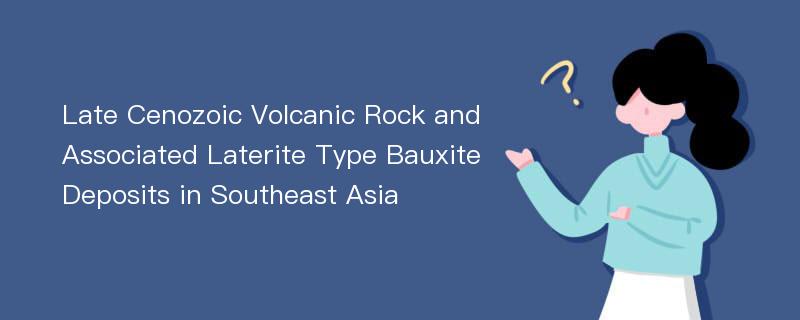
论文摘要
1 Introduction The Southeast Asia region have eleven countries, includes Myanmar, Cambodia, Indonesia, Thailand, Vietnam, Laos, Malaysia, Philippines, Brunei, East Timor and Singapore, and is endowed with a diversity of mineral resources(Khin Zaw et al., 2014). Tin, copper, nickel, gold, iron,bauxite, chromium and potash resources are widely distributed in the Southeast Asia, show considerable economic significance, have obvious complementarity to China, especially the laterite type bauxite, and is paid wide attention by Chinese geologists and mining industry in recent years. Although the exploration and development degree of laterite type bauxite in Southeast Asia is very low, studies show that the Southeast Asia will be one of the most important bauxite suppliers and resource bases in the world in the coming years(Yokart et al., 2003; Khin Zaw et al., 2014). With the discovery of several world-class mineral deposits, the reopening of a number of old mines and the improvement of exploration technical level, the metallogenic studies and mineral exploration have attracted increasing attention among the international mining communities. In carrying out the idea of "two types of mining markets and two kinds of mineral resources" in China, the Southeast Asia will be one of the best choices. Although the Southeast Asia is still frontier area for exploration and mining, the present activity of exploration is very promising. For the purpose of clear understanding of the crust evolution and regional metallogeny, this introductory paper provides a summary of the geological features, temporal–spatial distribution regularities and metallogenic characteristics of the laterite type bauxite deposits in Southeast Asia. Meanwhile, the regional geological and tectonic setting and laterite type bauxite ore-forming processes have also been discussed. The purpose of this study is to fill the knowledge gap of our understanding of the metallogenic characteristics of laterite type bauxite associated with the Late Cenozoic basalt in Southeast Asia. To better find new laterite type bauxite deposits in the Southeast Asia, we should conduct more detailed researches both on regional metallogeny and on individual mineral deposits. 2 Regional Geological and Tectonic Setting The formation of mineral resources was associated with a long and complex tectonic evolution history of Gondwana Supercontinent break-up, arc magmatism, backarc basin development, together with arc-continent and contient-continent collisions in Southeast Asia(Khin Zaw et al., 2014). Mainland Southeast Asia is located at the zone of convergence between the Asia, India-Australia, and Philippine sea-Pacific Plates(Metcalfe, 2011 a,b, 2013). The present day Southeast Asia is the result of more than 400 millon years of continental rifted away from the northwestern Gondwana margin at different epochs in the Phanerozoic which led to the Palaeo-Tethys, MesoTethys and Neo-Tethys were opened and sequently destroyed,
论文目录
文章来源
类型: 国际会议
作者: CHEN Xifeng,YE Jinhua,CHEN Xiufa
来源: 第九届世界华人地质科学研讨会 2019-06-01
年度: 2019
分类: 基础科学,工程科技Ⅰ辑
专业: 地质学,地质学,矿业工程
单位: Development and Research Center,China Geological Survey
分类号: P588.14;P618.45
DOI: 10.26914/c.cnkihy.2019.028285
页码: 23-24
总页数: 2
文件大小: 82k
下载量: 2
